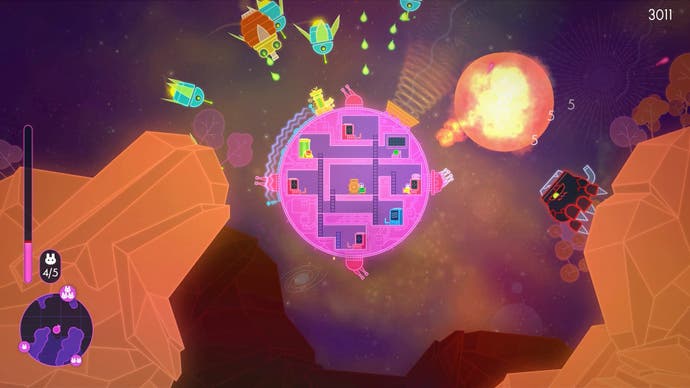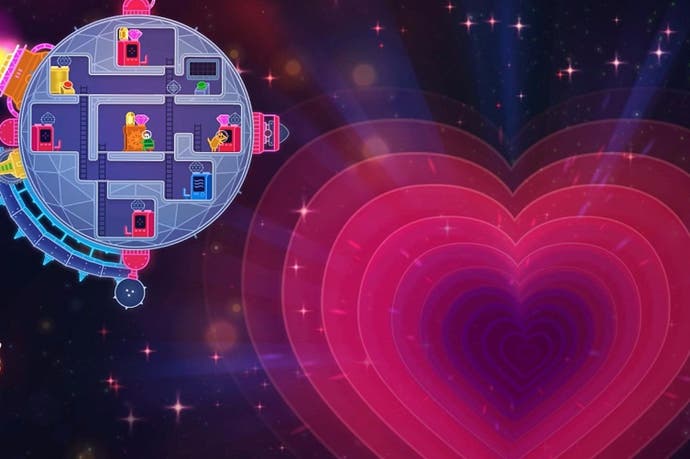Lovers in a Dangerous Spacetime review
Get a moon.
Lovers in a Dangerous Spacetime is released on PlayStation 4 this week. Here's our review dating from the Xbox One and PC release on 9th September 2015.
Lovers in a Dangerous Spacetime is a game about relationships. In the first instance, it's that old video game story about the relationship between objects and space: you must pilot your cumbersome blancmange of a ship through a tight warren of tunnels and asteroids, taking care not to deplete its shields in collisions. This much is familiar. Where the Canadian-made game develops the theme is in asking you to manage not only your ship's movement through space, but also (and simultaneously) your character's movement through the ship's interior.
A side-slice view of your craft allows you to peer into its decks and halls like a child nosing over a doll's house. The ship is burdened by a higgledy design. The steering wheel is, for example, housed in a different room to the shield controls, which are in a different place to the map room. Before you can utilise any of these various functions, you must first relocate your character to the appropriate room, climbing ladders and leaping platforms as quickly as possible on the inside, in order to manage the situation on the outside. Where most game designers try to streamline their designs, smooth off the friction and map the game's controls to a different button, developer Asteroid Base Inc. chooses to obfuscate.
It's also a game about human relationships. Play with a friend and you'll both assume the role of an astronaut, complete with upturned fish bowl over the head. Together, you must wrangle the ship's functions, screaming at one another to, for example, man the shields, or rush to the upstairs turret. Your chances of success hinge on the quality of your communication. Race to man the same turret and you will be utterly vulnerable for the ten seconds it takes you sort out who is actually going to sit in the seat, time during which your ship is both stationary and undefended. It's in these moments of frantic haplessness that Lovers in a Spacetime sparkles.

Play by yourself and you will be paired with an AI, either a dog who goes by the name of Doppler, or a cat called Kepler, a wing-pet that will prove essential to your survival. Here the game's demands become even greater, as you must move not only your character about the ship, but also your co-pilot, ordering him to different locations to defend, attack or check the map. Played solo, the game takes on a different, cooler quality. Here the mistakes aren't quite so funny. Either way, the design sounds unworkably complicated on paper, but in the hands you soon learn to manage the relationship between the ship's interior and the exterior, and between your ship's pilot and co-pilot.
The game's challenge derives specifically from the ship's design, rather than the demands the game makes upon your dexterity. Four of its seven stations control gun turrets which are immovably positioned on the four points of a compass: top, bottom, left and right. The engine station is located at the centre of the ship, and must be manned before it is able to move. The shield station controls the location of ship's flawed armour, which protects less than a quarter of the exterior, and must be move around to provide protection from enemy bullets and knocks. Finally, the Yamato laser system has its own room. This powerful weapon automatically skirts the edge of the ship's circumference, auto-firing for a few seconds when it's triggered. You are well-tooled, then, but also understaffed. If you have a crew of five, you would be unstoppable. But with just two of you on board, you must constantly make crucial decisions about where to sit. Do you concentrate on piloting the ship, leaving your co-pilot only able to shoot at enemies that come at you from one specific direction? Or do you anchor the ship, and man the opposite turret to help him out?
Outside you are searching for space frogs, which have been captured and caged around the game's randomly generated levels (or, in some cases, swallowed up by larger enemies). Collect five frogs and you unlock the stage's giant pulsing heart portal, which leads to the next stage. While you only require five frogs to progress, each stage actually homes ten frogs, and rescuing these extra hostages will level up your character and ship more quickly, so it's worth taking the time.
The difficulty soon ramps up and some asteroid chambers, for example, will have a cage of frogs at their centre. But when you arrive at the location, the cage disappears and you're besieged by enemies. In these situations, if you rely on your co-pilot to do all of the shooting, while you attempt to pilot around the space, you will inevitably explode. At these moments, you need to step down from the captain's chair and man a turret. In some asteroids, which are filled with water, your ship will start to spin, meaning you'll have to hop from turret to turret in order to control the incoming swarm. It's hectic and disorientating. When you fail it's enormously frustrating, an emotion that isn't quite matched in intensity by the feeling of elation when you triumph.
On your journey you collect gems, which can be installed to each of your ship's seven stations to alter their behaviour. Install a metal gem in the engine room, for example, and you'll leave a trail of spikes in your path, spat out by the exhaust pipe. Apply the same gem to the shields and it transforms your protective layer into a spiked, medieval carapace, one that can be used to barge into aliens. Later, you'll be able to install upgrades that allow you to add multiple gems to a single module and, like in Treasure's seminal Gunstar Heroes, create paint mix-like combinations of attack and defensive capabilities. These gems are stripped from your ship when you defeat a chapter's final boss, but the broader capabilities of the ship carry over.
Nevertheless, on the default difficulty, Lovers in a Dangerous Spacetime is a far more challenging game than its sugar pop styling suggests. A competent two-person team will be able to make consistent progress, but play alone and you're in for a tough journey. As the title suggests, this is a game best played in pairs. And even then, love is far from guaranteed.



